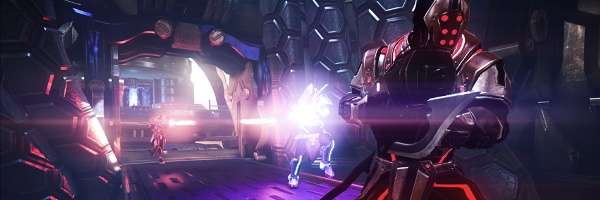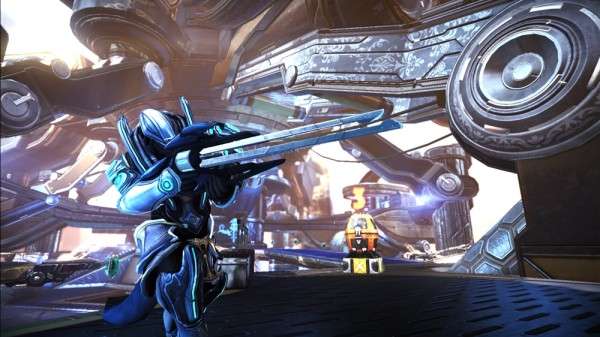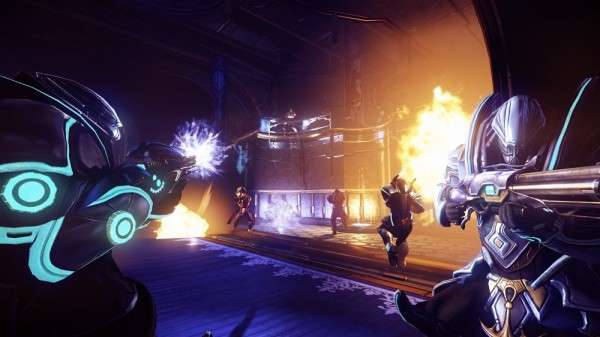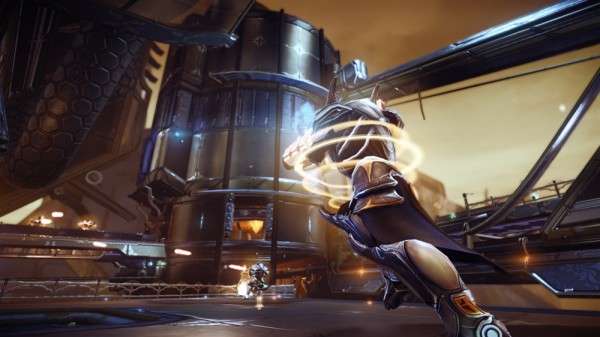
Nexuiz Xbox 360 Review
In terms of first-person shooters, no series equal the Unreal, Quake, and TimeSplitters games in terms of frantic shooter experiences. However, it’s been quite some time since these games were at the forefront of the shooter genre. They’ve been replaced by shooters like Halo and Call of Duty, games that allow for a measure of strategy while you wildly hope to land a shot to someone’s head. While these are in no way a poor evolution of the genre, we haven’t seen a game come close to honoring and improving Unreal’s unique style in quite some time. Enter Nexuiz, a game that has come quite some way from what was originally a 2005 open-sourced PC game based on a Quake mod. It’s fast-paced and attempts to fill the niche of ridiculously fast first-person shooters, but does Nexuiz do justice to its legacy?
In a word… mostly.

The game begins with a short cut-scene that explains the plot and motions behind your involvement in the Nexuiz battle-arena. You are, depending on the match, a member of one of two warring communities. After finally resolving decades of warfare through a peace treaty, the races decide to resolve whatever ill-will remains between them within a battle arena. Part entertainment, part pride, the arena functions as an important social event for these communities, or so the game would have us believe. Beyond the initial introduction and a few loading screens that explain an arena’s history, the game barely refers to the story. In a way, the lack of story focuses your attention towards the gameplay, but there’s a intriguing history here that ultimately feels like a missed opportunity.
In terms of balance, the gameplay leans heavily towards towards online multiplayer. While there is a “career mode” in single-player, it amounts to just playing against bots over the game’s nine different arenas. The single player matches have no ranking or statistical system attached to them, so apart from learning the basic gameplay, there’s little reason to return once you’ve practiced. Make no mistake – this is an online-heavy shooter.

The various arenas all encourage exploration and are designed with a specific game mode in mind. Six maps are available for Team (Death) Match, while the other three are reserved for Capture-the-Flag. Each match plays out in ten minutes, so don’t worry about lengthy battles – speed is the name of the game. There’s no sprint button, but the game accommodates with a jump button that you will use. Quite a bit. Expect every firefight to turn into a jumping battle – in an age of sniping, weapon drops, and knives-in-the-back, it’s a bit nostalgic to just frantically fire and jump at online enemies.
You can play up to four-on-four matches, and the attention to detail from developer Illfonic shines through as the game becomes more frantic. You’re constantly going through portals, stepping on jumps, and traversing multiple floors to find opponents, and the frame rate never stutters even in the most intense moments where all eight players are fighting in a small area.

The game runs on CryEngine3, and consistently looks beautiful. Maps based on crumbling ruins and futuristic societies are easily handled, while the different types of foliage and grass scattered throughout certain levels appear as good here as they do in a title like Halo: Reach. Lighting effects and shadows are particularly impressive. In arena shooters, numerous kinds of equipment and armor tend to be scattered around the landscape. Lighting around these pickups is often a problem, as exaggerate glows and shadows try to ensure you don’t miss anything. Not in this game. I don’t use this lightly (pun intended), but the effects are stunning. You’ll never have problems locating outlets and exits in darker areas, and don’t be surprised if you find yourself distracted by the game’s beauty while you wait to respawn.
The outstanding graphics are complimented by the intuitive screen layout. Your on-screen sensors are friendly and barely noticeable. In the top left, the score and remaining time in the match are relegated to small bars, while various other icons hold to the edges of the screen. You will have to read the included game manual at the title screen to understand what each icon represents, but that’s a little qualm for a game that wants you to remember gameplay is really what matters.

The powerups – known as mutators – are by far the most enjoyable part of each match. The game has at least 75 different mutators that you can possibly uncover, each one serving a unique purpose of helping, hurting, or just entertaining you. Mutators like Double Strength, Low Gravity, Infinite Ammo, Slow Enemy Fire, and Enemy Teleportation (which is just downright evil) could all impact the game at any moment, making for an experience that drastically changes from match to match. During one of my first matches, I picked up what looked like a glowing atom to find that I could select one of three mutators. Each option is assigned to the d-pad, so I picked the one that said “Mute Colors,” assuming that the other team would experience its effects. Wrong. After waiting three seconds (an interesting twist that delays the mutator’s effect and is the game’s most strategic aspect), I was surprised to see my screen turn to black and white. Shortly thereafter, I had fired at each of my teammates in fear they were the enemy. They weren’t. I received appropriately tart, colorful responses and had learned to be more careful about activating whatever mutator looks best. These mutators are incredibly fun to use, and discovering a new one even after dozens of matches kept me hoping to find just one more.
Weapons range from a variety of guns, but there are, in what might be another missed opportunity, no small explosives in the game. Grenades are nowhere to be found, but you can pick up a mortar gun and hope for the best. There is a melee button, but you’ll rarely use it. Some mutators – like Sticky Rounds – allow you temporarily to upgrade your guns, turning a normal rocket shell into a sticky rocket shell that you can lay for an unsuspecting enemy. While you might initially be presented with completely random mutators, the game’s unique reward and achievement system allows you to tailor your character’s mutators preferences before a match to create dynamic mutators.

For every kill, kill streak, or flag capture, you earn points that can be used after the match to increase the likelihood you might pick up a particular mutator in the next match. Yet this system requires quite a bit of dedication – after six matches, I had earned enough points to unlock just one tier of one mutator (and each tier is more expensive than the last). For a casual player, this isn’t an issue. But more committed players will want to settle in for a grueling process if you hope to strategize through dynamic mutators. Another qualm is that beyond a few interesting weapons like your starting shotgun and a pseudo-plasma rifle, there’s no real gun that really stands out as memorable (remember Unreal Tournament’s Redeemer?). With the incredible amount of mutators in the game, it’s surprising that the developers chose to limit the number of different types of weapons and arenas where they can be used. Hopefully, the console version of the game has as a life as long as the PC mod, and the developers release more maps and weapons in the near future.
Until then, apart from the points you garner from killing them, no real satisfaction comes from killing an enemy beyond earning points. The points are a nice change to the fast-action shooter formula and lets you know how well you’ve been playing, but they’re really no different than credits in other shooters, and limiting their use to just dynamic mutators makes you realize how much you would like unlockable weapons or arenas, or even the option of adding a little flair to your battle-arena contestant.

Additionally, the gaming lobby has very little to offer in terms of building a lasting community for the game. You can create a custom match and invite your friends to play it with you, but there is no option for picking what game mode you prefer. If you happen to play six games of capture-the-flag in a row, tough luck. There’s also surprisingly long wait times when searching for a match. I tried playing in the morning, afternoon, and evening for this review, and I experienced evening load times – when the lobbies should have been fullest – that were nearly as long as the rest of the day. Make no mistake – I am a believer in patience, but when you have to wait nearly as long as a normal match, it drains whatever momentum you might have had and limits the appeal of playing online. There’s also no penalty if a player drops out or loses connection during match; even more upsetting is that there is no auto-balance for those games. If you find yourself on the short end of a four-on-two match, well, you have my prayers because those numbers won’t change.
I would be remiss if I didn’t mention what was the most surprising and entertaining moment of Nexuiz. There is a specific mutator that affects the sound effect of your guns and movements – a hilarious moment that really emphasizes how much fun the developers want you to have with this game. If consequential updates offer more arenas, game modes, and a few other balancing gameplay changes, this game could have a lasting power that other titles can’t even imagine. At a cheap 800 Microsoft points, the game certainly merits trying. It goes without saying that as more people purchase it, the game’s experience will only become better. Until then, long load times and a tough reward system ensure that it certainly caters to the niche of insanely fast-shooters, but might be unforgiving and underwhelming to other types of gamers.
